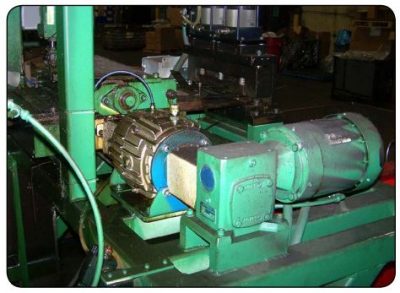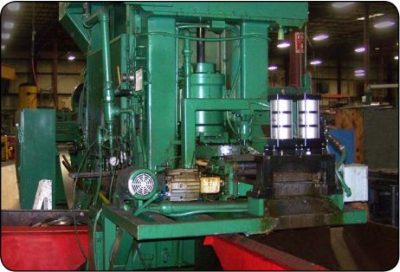In the metal stamping business, precision, repeatability and uptime are key. But stamping accuracy suffers when improper tension on the coil feeders incorrectly supplies metal to the presses, resulting in off-spec parts and increased rejections. ART Technologies relies on an oil shear clutch brake to supply constant, reliable tension on the coil feeding one of their 400-ton presses to give them the precision and repeatability they need, with no downtime for maintenance or adjustment. When the plant is working 20 hours a day, that uptime is as critical as the tolerances they maintain.
ART is a full-service global supplier of precision metal stamping components, thrust bearings and coining services for raceways and washers. With 11 presses ranging in size from 45 to 800 tons, they stamp out a wide range of products for the automotive, truck, bus, solar, HVAC, agriculture, defense and other industries.
They currently operate a single shift, but when business demands it they operate two ten-hour shifts, or nearly around the clock. Whether they are cranking out miniature thrust bearings for the automotive industry or thick stampings for the truck market, repeatability is key in all that they do.
A Pressing Problem
One of their Minster 400-ton presses has a ½ hp motor which pulls the stock strip though the press, keeping tension on the steel at all times. This tension is a necessity because of the Die Design, and ensures consistency of the stamped product and optimal productivity. Engineering Manager Fred Meinhardt, explains it this way: “We need to keep tension on the stock and to be able to run the drive unit at a speed slightly faster than the feed, so that when the feed stops, the clutch slips. When the feed restarts again, the stock tensioner takes up the slack and keeps tension on the stick as it moves forward.”
The company had been using a mechanical clutch that was slipping all of the time, with unsatisfactory results, including feed problems, out- of-spec parts, and press down time. In addition to the production problems, the dry friction clutch would wear and require adjustment, maintenance or replacement, to the tune of four to five hours per week. According to Meinhardt, the production loss due to downtime was 20 percent.
Meinhardt estimates that the old style clutches were replaced every six months or so, in addition to the four to five hours per week of maintenance. At the time, the plant was working two 10-hour shifts, or nearly round-the-clock, so that level of weekly downtime for maintenance and adjustment was substantial and unacceptable. To top it off, the extra time to replace the clutch-brakes was even more troublesome, because the failures rarely occurred at convenient times. Then Meinhardt found help right around the corner, literally.
“My brother works for Force Control Industries (the manufacturer of the oil shear clutch brake) which is within a mile of our plant, so I knew all about their capabilities,” he said. Installing the oil shear clutch break was hassle free, and the little effort required reaped a significant return on investment. In the two years that the Posidyne 1.5 clutch brake has been installed on the ½ hp motor to tension the coil stock, there has been no unscheduled downtime for maintenance or repairs. At two years and running, the Posidyne 1.5 has already lasted 4-times longer than the dry clutch, and is still working fine.
How Oil Shear Technology Works
Normal dry clutch brakes employ a sacrificial surface—the brake disc or pad—to engage the load. Having no good way to remove the heat caused from engagement between the disk and plate, this material must absorb the heat. These extremely high temperatures will eventually degrade the friction material. As the friction surface wears away and begins to glaze, the ensuing torque fade causes positioning errors, which then require adjustment or replacement of the friction surface.
Oil-shear technology plays a major role in ensuring that the coil feeders at ART Technologies operates at peak efficiency—even at a much higher cycle rate. A fluid film flows between the friction surfaces, and is compressed as the brake is engaged. The Automatic Transmission Fluid (ATF) particles in shear transmit torque to the other side. This torque transmission causes the stationary surface to turn, bringing it up to the same relative speed as the moving surface. Since most of the work is done by the fluid particles in shear, by the time the surfaces actually meet or “lock up” wear is virtually eliminated.
In addition to transmitting torque, the ATF also helps to dissipate heat, thanks to a patented fluid recirculation system. Along with torque transmission and heat removal, the fluid also serves to continually lubricate all components—thus extending their service life. Oil Shear Technology also provides a “cushioned” stop that reduces shock to the drive system—further extending service life.
Unlike dry clutch brakes, the totally enclosed oil shear system is impervious to external elements such as wet, dusty or dirty environments, as are common in many manufacturing plants. Since the layer of oil eliminates wear, the Posidyne clutch brake provides a long service life. With elimination of wear comes elimination of adjustment—and increased “uptime” for ART Technologies.
The reliability and durability of oil shear technology helps plants with a critical pathway maintain high production. Oil shear technology has helped ART Technology’s plant increase precise control and stamp out downtime. Production is up 20 percent, with reduced scrap rates, fewer out-of-spec parts, and more parts per coil. The resulting efficiency and profitability keeps ART’s machines precise and reliable—giving them a competitive edge in a competitive industry.
For more information:
ART Metals Group Phone: (513) 942-8800 www.artmetalsgroup.com Force Control Industries Phone: (800) 829-3244 www.forcecontrol.com
APRIL 2017 Power Transmission Engineering


